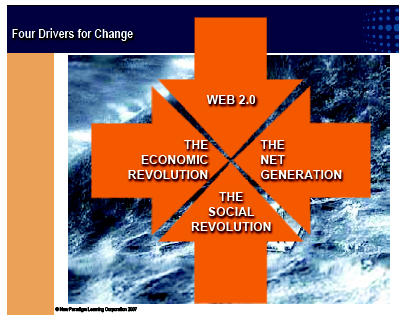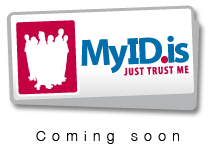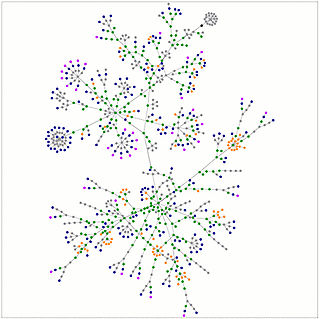Je serais à la Web2.0 expo de Berlin la semaine prochaine. L’événement a son propre réseau social, ça permet déjà de prendre la température: L’Entreprise 2.0 et les réseaux sociaux sont au coeur des préoccupations des participants, ça tombe bien c’est pour ça que j’y vais.
J’y serais du mardi au jeudi, je tacherais de blogguer mes notes en live ou le soir, en attendant voici une liste (non exhautive) des confs que je ne veux pas rater
de 9H à 9H50 Moving from 1.0 to 2.0: Philosophies and Structures for Change
The 2.0 web world is more than just embedded technology – it is a philosophy. Companies who embrace this thinking are more flexible, agile, and innovative in their strategy and approach, but moving in this direction means rethinking structure, management style, workflow, and culture.How teams are structured, educated, and implemented in your organization is key. Are you a design firm, individual freelancer, or corporation trying to migrate past ‘old-school’ thinking and move yourself, management, or team into a more progressive era? Come hear how others have made innovation a priority – through carefully guided leadership and an environment that fosters creative thinking and collaboration.
A moins que je ne suive: Killing the Org Chart: Organizational, Cultural and Leadership Models on the Bleeding Edge, sur le même thème, malheureusement au même moment.
Ca démarre de suite avec le coeur du sujet “entreprise2.0”: La culture, est-ce que l’entreprise à “culture 2.0”? Si non, comment faire pour l’acquérir?
de 10H10 à 11H10 Opening the Social Graph
As you move from one social network to another, you’re forced to re-declare not just your profile, but to find all of your friends all over again. Freely giving away the username and password to your online email address book has become a modus operandi when joining any new online service. Fortunately open standards and technologies can help to solve this problem. OpenID is already taking root and helping to put control of your identity online back into your hands, Microformats make it easy to exchange profile information in a standard fashion, and new technologies like OAuth allow for richer integration between services in a more secure and user mediated fashion. Each social network consists of people and relationships, making up a small part of the entire social graph spanning the 6.6B people in the World. Shouldn’t technology help you move your relationships between services as well? With a bit of glue between these standards, this is becoming increasingly possible with many companies and services working to make it a reality.
J’en parlait justement dans mon billet sur open data.
11H20 – 12H10 Designing for a Web of Data
Design patterns for brochureware and editorial sites are well-established. In fact, they’re so simple and formulaic that even waterfall development processes can churn them out. A producer has an idea, a designer mocks it up in Photoshop and then client-side types and engineers go all agile on its ass. But what happens when you’re pushing into web apps or social media? What happens when an absence of hierarchy makes left-hand navigation redundant? What do you do when design practice blurs into URLs and data structures, and where your service breaks the frame of the browser and start appearing in hardware, in desktop applications or on other people’s sites?In this session, Tom will talk about new literacies that designers need to build things that are native to a web of data, the blurring and interplay between designers and developers and what it means to rapidly iterate in small multi-disciplinary teams to find the heart and soul of a new concept.
Les applications web2.0 c’est aussi ça, une autre manière de faire la conception.
15H50 – 16H40 Short on Cycles, Long on Storage
Utility computing takes the ideas of utility energy provision and applies it to the world of IT, so that companies buy computing resources in much the same way that they buy electricity – charged according to metered usage. This market is growing, and will continue to grow in three distinct areas – SaaS, FaaS and HaaS. It heralds in a new way of operating on the web, benefiting developers by reducing “yak shaving”, business by reducing non-strategic costs and it may even benefit Ducks. This session covers the concepts, economics, technologies, players, benefits and pitfalls as well as the future development of this field. It also explains what this might mean to those who work in IT, how the relationship between IT and Business will change, how new markets should form and why Ducks matter.
Celle là je vais la suivre pour Christian, on y parle du SaaS!
9H – 9H50 Web 2.0 Design Patterns, Models and Analysis
Many enterprises seek knowledge of the design patterns used by successful Web 2.0 companies. This session starts with Tim O’Reilly’s list of Web 2.0 examples and distills the abstract architectural patterns from behind the examples. By using the patterns notation, the core knowledge of the design principles is preserved in a template which can be reused in multiple contexts.Duane will also show the evolution of the client server model into a 5-tier model based on the consistent concepts of most successful Web 2.0 patterns. The model serves as a useful starting point for anyone either designing business models or technology for Web 2.0. The Web 2.0 model is also used to illustrate a reference architecture. This abstract set of technology components allows developers to start thinking about the types of technology decisions required for building Web 2.0 projects.
Design pattern, architecture, avec de tel mots clés je ne peux pas manquer cette session!
10H10 – 11H I tube, you tube, we tube. Unlimited content, unlimited liability?
Is the legal framework in Europe ready for Web 2.0? How are Web 2.0 Services liable for user generated content? How does the legal framework and legal risks affect business models? Learn about the evaluation and the development of the European legal framework for internet and media. Get informed about legal risks and how to avoid them in Web 2.0.
Cette fameuse question des droits d’auteur.
11H20 -12H10 The Impact of Mobile Web 2.0 on the Telecoms Industry
With the launch of the iPhone, the Telecoms industry enters a new and a disruptive phase – the drivers of which are no longer the traditional players in the industry. This session explores the synergies between the web and the Telecoms industry. It outlines the opportunities and the disruptive influences of the Web on the Telecoms industry. Traditionally the Web and the ethos of the web (open standards, interoperability, etc.) are viewed with suspicion by the telecoms industry. The Telecoms industry in general, does not trust the Web. It is almost as if it chooses to ignore the ‘Web’ in ‘Mobile Web 2.0’. But the Web forms the bedrock of Tim O’Reilly’s seven principles defining Web 2.0 and it is not possible to ignore the Web any more – especially considering the rapid growth of User generated content. Unless it adapts to the web, the industry risks missing out on the huge opportunities that can be leveraged through the power of Mobile Web 2.0. This session talks about the Good, the bad and the ugly – in the interplay between the web and Telecoms.
Le web et les télécoms une grande histoire d‘amour.
17h – 17H50 Conversational Design
Once we progress from the user-centered design model to community-centered design we’ll need to identify and gather a similar set of best practices regarding community design. This presentation collects the key features and interactions that a successful community should display in order to empower its users and facilitate conversation between its members. The transition of user’s role from consumer to producer requires that those who produce online and offline services not only to understand the process by which the conversation happens but also which interface mechanisms and flows should be present in their interfaces.This presentation aims to be a bridge between Usability Best Practices and Community Centered Design, a practice that can maximize the networking and crowd effect under online user communities.
10H10 – 11H Enterprise 2.0: Tools for Changing Organizations
The user experience is more critical today with the emergence of Web 2.0 during the past few years. Today wikis, blogs, and widgets are a part of the daily nomenclature in the work environment, but there are many questions around how this Web 2.0 world moves into the Enterprise world. How do software vendors bring the best features and functionalities to the masses? Are these companies spending their R&D on bringing to market small applications that focus on one task or are they focused on improving their core applications, or is both possible? Do Web 2.0 apps have enough speed, security, and stability for the Fortune 500 CIOs and thousands of employees around the world? This panel will explore the intersection of the Web and Enterprise 2.0 worlds and discuss what is ready for prime time.
11H20 -12H10 Choosing the final RIA path or Choosing the appropriate RIA Technology
Rich user interfaces and a satisfactory user experience are fundamental factors of Rich Internet Applications. Improved productivity, more effective work, time and cost reduction in the field of both operations and applications development are an important plus which deserves to be higlited when evaluating the suitability of tecnologies for applications projects. New development approaches have recently come to market : Flex, AIR, Flash, XUL, OpenLazlo, Silverlight, WPF, JavaFX. There are so many different technologies that it’s easy to lose focus and misjudge goals when choosing a RIA platform. How to choose the best technology? What are their advantages? Which one is going to get the widest adoption? What can you do with them? This session guides you through the ecosystem of RIA’s technologies, analyzing and comparing the benefits, features and disadvantages of each approach. Make the final RIA choice for your web applications.
15H – 15H30 Enterprise 2.0
Pour finir en beauté.


 déjà avoir une petite idée du sujet auquel s’attaque Charles: l’Identité Numérique. Ce n’est pas forcément évident au premier abord mais on est en plein coeur de la problématique web2.0. D’ailleurs Il a beaucoup été question d’openID durant l’expo, myid.is est une implémentation d’openID.
déjà avoir une petite idée du sujet auquel s’attaque Charles: l’Identité Numérique. Ce n’est pas forcément évident au premier abord mais on est en plein coeur de la problématique web2.0. D’ailleurs Il a beaucoup été question d’openID durant l’expo, myid.is est une implémentation d’openID.